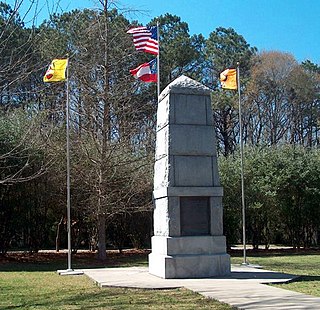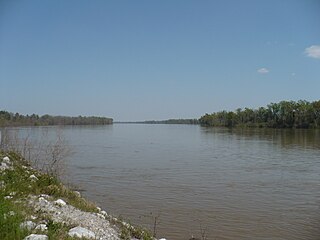
The Trail of Tears was a series of forced relocations of Native Americans in the United States from their ancestral homelands in the Southeastern United States, to areas to the west that had been designated as Indian Territory. The forced relocations were carried out by government authorities following the passage of the Indian Removal Act in 1830. The relocated peoples suffered from exposure, disease, and starvation while en route to their new designated reserve, and many died before reaching their destinations. The forced removals included members of the Cherokee, Muscogee (Creek), Seminole, Chickasaw, Choctaw, and Ponca nations, as well as their African slaves. The phrase "Trail of Tears" originates from a description of the removal of many Native American tribes, including the infamous Cherokee Nation relocation in 1838.

Washington County is a county in the U.S. state of Alabama. As of the 2010 census, the population was 17,581. The county seat is Chatom. The county was named in honor of George Washington, the first President of the United States. It is a dry county, with the exception of Chatom.

Clarke County is a county located in the U.S. state of Mississippi. As of the 2010 census, the population was 16,732. Its county seat is Quitman. Clarke County is named for Joshua G. Clarke, the first Mississippi state chancellor and judge.

The term "Five Civilized Tribes" derives from the colonial and early federal period in the history of the United States. It refers to five Native American nations—the Cherokee, Chickasaw, Choctaw, Creek (Muscogee), and Seminole. These are the first five tribes that Anglo-European settlers generally considered to be "civilized". Examples of colonial attributes adopted by these five tribes include Christianity, centralized governments, literacy, market participation, written constitutions, intermarriage with white Americans, and plantation slavery practices. The Five Civilized Tribes tended to maintain stable political relations with the Europeans.

Pinckney's Treaty, also commonly known as the Treaty of San Lorenzo or the Treaty of Madrid, was signed in San Lorenzo de El Escorial on October 27, 1795 and established intentions of friendship between the United States and Spain. It also defined the border between the United States and Spanish Florida, and guaranteed the United States navigation rights on the Mississippi River. With this agreement, the first phase of the ongoing border dispute between the two nations in this region, commonly called the West Florida Controversy, came to a close.

The Territory of Mississippi was an organized incorporated territory of the United States that existed from April 7, 1798, until December 10, 1817, when the western half of the territory was admitted to the Union as the State of Mississippi and the eastern half became the Alabama Territory until its admittance to the Union as the State of Alabama on December 14, 1819.

The Tombigbee River is a tributary of the Mobile River, approximately 200 mi (325 km) long, in the U.S. states of Mississippi and Alabama. Together with the Alabama, it merges to form the short Mobile River before the latter empties into Mobile Bay on the Gulf of Mexico. The Tombigbee watershed encompasses much of the rural coastal plain of western Alabama and northeastern Mississippi, flowing generally southward. The river provides one of the principal routes of commercial navigation in the southern United States, as it is navigable along much of its length through locks and connected in its upper reaches to the Tennessee River via the Tennessee-Tombigbee Waterway.
George Strother Gaines had an influential role in the early history of Alabama and Mississippi. During his long and varied career he was a federal trade agent for the region's Indian tribes, explored the country west of the Mississippi River and supervised the removal of Choctaw Indians. He also served as a state senator, banker, and railroad lobbyist.

Fort Stoddert/Stoddard was a stockade fort in the Mississippi Territory, in what is today Alabama. It was located on a bluff of the Mobile River, near modern Mount Vernon, close to the confluence of the Tombigbee and Alabama Rivers. It served as the western terminus of the Federal Road which ran through Choctaw lands to Fort Wilkinson in Georgia. The fort, built in 1799, was named for Benjamin Stoddert also attributed to Amos Stoddard married to Phoebe Reed, contemporaries of Daniel Reed his wife Rose Reed and his brothers Amos Reed and Squire Reed, the secretary to the Continental Board of War during the American Revolution and Secretary of the Navy during the Quasi War. Fort Stoddert/Stoddard was built by the United States to keep the peace by preventing its own settlers in the Tombigbee District from attacking the Spanish in the Mobile District.

The Noxubee River (NAHKS-uh-bee) is a tributary of the Tombigbee River, about 90.6 miles (145.8 km) long, in east-central Mississippi and west-central Alabama in the United States. Via the Tombigbee, it is part of the watershed of the Mobile River, which flows to the Gulf of Mexico.

The Treaty of Doak's Stand was signed on October 18, 1820 between the United States and the Choctaw Indian tribe. Based on the terms of the accord, the Choctaw agreed to give up approximately one-half of their remaining Choctaw homeland. In October 1820, Andrew Jackson and Thomas Hinds were sent as commissioners who represented the United States to negotiate a treaty to surrender a large portion of Choctaw country in Mississippi. They met with tribal representatives at Doak's Stand on the Natchez Trace. They met with the chiefs Pushmataha, Mushulatubbee, and Apuckshunubbee, who represented the three major regional divisions of the Choctaw. Chiefs of the towns and other prominent men accompanied them, such as Colonel Silas Dinsmoor.

The Dancing Rabbit Creek Treaty Site is a historic Choctaw Native American gathering place in rural Noxubee County, Mississippi. Located near a freshwater spring above the floodplain of Dancing Rabbit Creek in the southwestern part of the county, it was the site of a treaty negotiation between the Choctaw and the federal government in 1830, resulting in the Treaty of Dancing Rabbit Creek, in which the Choctaw agreed to surrender their ancestral lands for territory in what is now Oklahoma. It was the first treaty negotiated after passage of the Indian Removal Act, and served as a model for other treaties passed pursuant to that act. It also led to the Choctaw Trail of Tears. The site, now marked by a stone memorial and a small Choctaw cemetery, was designated a National Historic Landmark in 1996.

The Choctaw Trail of Tears was the relocation of the Choctaw Nation from their country referred to now as the Deep South to lands west of the Mississippi River in Indian Territory in the 1830s. A Choctaw miko (chief) was quoted by the Arkansas Gazette that the removal was a "trail of tears and death." After removal the Choctaws became three distinct groups, the Choctaw Nation of Oklahoma, Jena Band of Choctaw Indians, and the Mississippi Band of Choctaw Indians.

Fort Sinquefield is the historic site of a wooden stockade fortification in Clarke County, Alabama, near the modern town of Grove Hill. It was built by early Clarke County pioneers as protection during the Creek War and was attacked in 1813 by Creek warriors.

Half Acre is an unincorporated community in Marengo County, Alabama, United States. It has gone through a variety of name changes since the early 20th century. The community had a post office at one time, but it no longer exists. Although a thriving community in its early years, it has since dwindled into obscurity.

The Tombigbee District, also known as the Tombigbee settlements, was one of two areas, the other being the Natchez District, that were the first in what was West Florida to be colonized by British subjects from the Thirteen Colonies and elsewhere. This later became the Mississippi Territory as part of the United States. The district was also the first area to be opened to white settlement in what would become the state of Alabama, outside of the French colonial outpost of Mobile on the Gulf Coast. The Tombigbee and Natchez districts were the only areas populated by whites in the Mississippi Territory when it was formed by the United States in 1798.
Horse Creek is a stream and tributary of the Tombigbee River in southern Marengo County and northern Clarke County in Alabama.
The Treaty of Dewitts Corner ended the initial Overhill Cherokee town attacks which took place at the beginning of the American Revolution. Signed between the Cherokee and South Carolina, the treaty helped lay the foundation for the decades long Cherokee–American wars fought between the European-Americans and the Chickamauga Cherokee people.
























